
A horseshoe is a fabricated product, normally made of metal, although sometimes made partially or wholly of modern synthetic materials, designed to protect a horse hoof from wear. Shoes are attached on the palmar surface of the hooves, usually nailed through the insensitive hoof wall that is anatomically akin to the human toenail, although much larger and thicker. However, there are also cases where shoes are glued.

Debeaking, beak trimming, or beak conditioning is the partial removal of the beak of poultry, especially layer hens and turkeys although it may also be performed on quail and ducks. Most commonly, the beak is shortened permanently, although regrowth can occur. The trimmed lower beak is somewhat longer than the upper beak. A similar but separate practice, usually performed by an avian veterinarian or an experienced birdkeeper, involves clipping, filing or sanding the beaks of captive birds for health purposes – in order to correct or temporarily alleviate overgrowths or deformities and better allow the bird to go about its normal feeding and preening activities. Amongst raptor-keepers, this practice is commonly known as "coping".
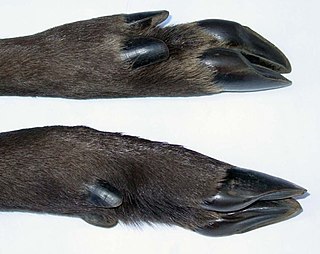
A hoof, plural hooves or hoofs, is the tip of a toe of an ungulate mammal, strengthened by a thick and horny keratin covering.

A farrier is a specialist in equine hoof care, including the trimming and balancing of horses' hooves and the placing of shoes on their hooves, if necessary. A farrier combines some blacksmith's skills with some veterinarian's skills to care for horses' feet.

Laminitis is a disease that affects the feet of ungulates and is found mostly in horses and cattle. Clinical signs include foot tenderness progressing to inability to walk, increased digital pulses, and increased temperature in the hooves. Severe cases with outwardly visible clinical signs are known by the colloquial term founder, and progression of the disease will lead to perforation of the coffin bone through the sole of the hoof or being unable to stand up, requiring euthanasia.
Navicular syndrome, often called navicular disease, is a syndrome of lameness problems in horses. It most commonly describes an inflammation or degeneration of the navicular bone and its surrounding tissues, usually on the front feet. It can lead to significant and even disabling lameness.
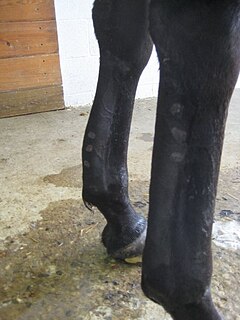
Tendinitis/tendonitis is inflammation of a tendon, often involving torn collagen fibers. A bowed tendon is a horseman's term for a tendon after a horse has sustained an injury that causes swelling in one or more tendons creating a "bowed" appearance.
There are many aspects to horse management. Horses, ponies, mules, donkeys and other domesticated equids require attention from humans for optimal health and long life.
Jaime Jackson is a former farrier, horse hoof care lecturer, author, and researcher of the wild, free roaming horses in the U.S. Great Basin. He is best known for the practice of natural hoof care first written about in The Natural Horse: Lessons from the Wild (1992). His later work "Paddock Paradise: A Guide to Natural Horse Boarding" became a foundation for the alternative boarding system also known as Track System. Jackson's work focuses around Four Pillars of Natural Horse Care.
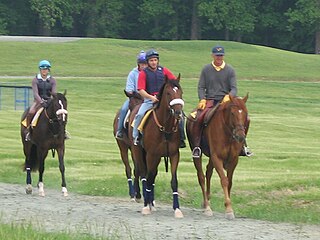
Barbaro was a champion American Thoroughbred racehorse who won the 2006 Kentucky Derby but shattered his leg two weeks later in the Preakness Stakes which ended his racing career and eventually led to his death.
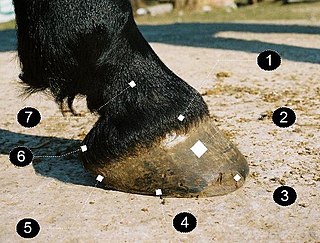
A horse hoof is a structure surrounding the distal phalanx of the 3rd digit of each of the four limbs of Equus species, which is covered by complex soft tissue and keratinised (cornified) structures. Since a single digit must bear the full proportion of the animal's weight that is borne by that limb, the hoof is of vital importance to the horse. The phrase "no hoof, no horse" underlines how much the health and the strength of the hoof is crucial for horse soundness. A 2018 study has found that it may possibly contain remnants of the horse's other digits.

Chronic progressive lymphedema (CPL) is a disease of some breeds of draft horse, whereby the lower legs becomes progressively more swollen. There is no cure; the aim of treatment is to manage the signs and slow progression of the disease. The cause of CPL is not known, although it is suspected that a genetic disorder of elastin metabolism prevents the lymphatic vessels from functioning properly, leading to edema of the lower limbs. CPL resembles the human disease elephantiasis verrucosa nostra.
Equine podiatry is the study and management of the equine foot based on its anatomy and function.
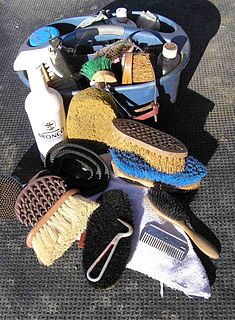
Horse grooming is hygienic care given to a horse, or a process by which the horse's physical appearance is enhanced for horse shows or other types of competition.
Lameness is an abnormal gait or stance of an animal that is the result of dysfunction of the locomotor system. In the horse, it is most commonly caused by pain, but can be due to neurologic or mechanical dysfunction. Lameness is a common veterinary problem in racehorses, sport horses, and pleasure horses. It is one of the most costly health problems for the equine industry, both monetarily for the cost of diagnosis and treatment, and for the cost of time off resulting in loss-of-use.

Nail prick or quicking occurs in a horse if the sensitive hoof structures are penetrated by a horseshoe nail being driven through the hoof wall while shoeing. The nail creates a wound on the inside of the hoof wall.
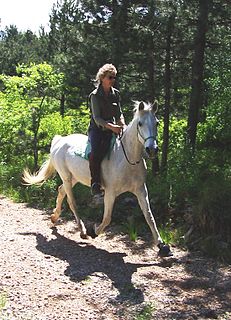
Natural hoof care is the practice of keeping horses so that their hooves are worn down naturally, or trimmed to emulate natural wear. So they do not suffer overgrowth, splitting and other disorders. Horseshoes are not used, but domesticated horses may still require trimming, exercise and other measures to maintain a natural shape and degree of wear.

The Horse Protection Act of 1970 (HPA); is a United States federal law, under which the practice of soring is a crime punishable by both civil and criminal penalties, including fines and jail time. It is illegal to show a horse, enter it at a horse show, or to auction, sell, offer for sale, or transport a horse for any of these purposes if it has been sored.
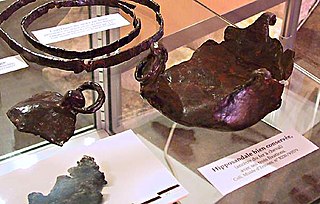
The hipposandal is a device that protected the hoof of a horse. It was commonplace in the northwestern countries of the Roman Empire, and was a predecessor to the horseshoe.
The treatment of equine lameness is a complex subject. Lameness in horses has a variety of causes, and treatment must be tailored to the type and degree of injury, as well as the financial capabilities of the owner. Treatment may be applied locally, systemically, or intralesionally, and the strategy for treatment may change as healing progresses. The end goal is to reduce the pain and inflammation associated with injury, to encourage the injured tissue to heal with normal structure and function, and to ultimately return the horse to the highest level of performance possible following recovery.












